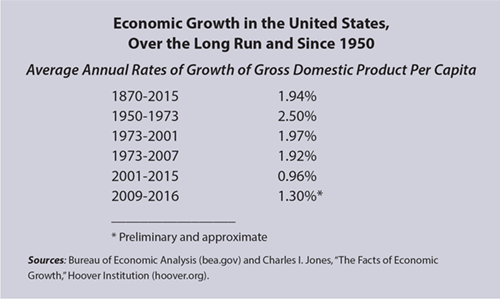This article is from Dollars & Sense: Real World Economics, available at http://www.dollarsandsense.org

This article is from the
July/August 2016 issue.
Subscribe Now
at a 30% discount.

Are We Stuck in a Period of Economic Stagnation?
Dear Dr. Dollar:
Is it really true (or likely) that the U.S. and world economies are entering an extended period of slow economic growth—that is, stagnation? —Aaron Shields, Maplewood, N.J.
Nowadays, among economists at least, everyone seems to be pessimistic about the future course of the economy. Larry Summers, a star among mainline economists, secretary of the treasury in the 1990s, and advisor to Barack Obama in more recent years, is perhaps the most prominent figure giving voice to the specter of stagnation. Most recently, in the March/April 2016 issue of Foreign Affairs, after reviewing the current poor performance of the U.S. and other economies, Summers wrote: “The key to understanding this situation lies in the concept of secular stagnation. ... The economies of the industrial world, in this view, suffer from an imbalance resulting from an increasing propensity to save and a decreasing propensity to invest. The result is that excessive saving acts as a drag on demand, reducing growth and inflation.”
Summers goes on to say that weak growth and investment can be temporarily overcome and demand maintained only by “dangerous levels of borrowing,” as in the early 2000s. The result was the housing bubble, the catalyst for the Great Recession.
Summers is not alone. A recent and much-cited book by Northwestern University economist Robert Gordon, The Rise and Fall of American Growth, makes a complementary argument. Gordon maintains that economic expansion from 1870 to 1970 was driven by five realms of innovations: electricity, chemicals and pharmaceuticals, the internal combustion engine, urban sanitation, and modern communications. He does not see any current development—particularly not information technology—that matches the impact on economic growth of any one of these five.
Gordon’s analysis, with periods of growth depending on major innovations, is similar to the Marxist analysis by the late Paul Sweezy, which has been continued and given emphasis now by his followers at Monthly Review magazine. Sweezy viewed capitalism as creating excess capacity, with investment creating new productive capacity which outstripped the demand for the products. Thus, this very success of capitalist production tended to undermine the basis for new investment. Further, the lack of sufficient demand was also a product of capitalists’ success—i.e., their ability to keep wages low. Sweezy referred to this phenomenon as “over accumulation,” where the success of capitalist production tended to create stagnation and undermine capitalist production—a prime contradiction of the system. For Sweezy, then, the normal state of capitalism is stagnation, and periods of growth were to be explained only by epoch-changing innovations—the steam engine, the railroad, and the automobile.
Poor Performance
The current focus on stagnation is a response to the poor performance of the U.S. economy so far in the 21st century. Since 2001, the annual growth of per capita GDP (adjusted for inflation) has been less than 1%. (See table.) By comparison, the average annual growth rate from 1870 to 2007 (the onset of the Great Recession) was twice that. Of course, the years since 2001 include the Great Recession. But most recessions have been balanced by sharp upward recovery, with a growth rate substantially above the average.

Not so this time. Since the nadir of the Great Recession in 2009, average annual growth of per capita GDP has been only about 1.3%. Moreover, in the years leading up to the Great Recession, even meager growth (about 1.7% per year) was attained only by the rise of debt and the housing bubble. These early-21st-century years saw a high level of debt-based construction, but there was limited investment in plant and equipment, which might have attenuated stagnation.
Further, both the severity of the Great Recession and the slow growth in the 21st century have been part of a longer-term development. Whereas annual average GDP per capita growth was 2.5% in the 1950 to 1973 period, it dropped to below 2% in the 1973 to 2007 years, just before the Great Recession and slow recovery. (Though this drop is significant, the growth rate of around 2% is in line with the average over the last 150 years.) Furthermore, as compared to recessions in the 1950 to 1973 period, recessions since 1973 have been substantially more severe (in terms of depth and length), with the Great Recession being the worst.
The Current Situation
While the grand theories of stagnation—the tendency in capitalism for savings to outpace investment, the absence of major innovations, and over-accumulation—are important, there are also some more particular factors that have contributed to slow economic growth in the United States and other “advanced” countries during the 21st century.
Lack of government demand creation. The well-known government response to recessions has been to run a fiscal deficit, enhancing aggregate demand. While the Obama administration did respond to the Great Recession with a stimulus program, it was clearly too small—thanks in no small part to advice from Summers, but also because of the anti-deficit mania that has become so widespread among politicians and the public.
Lack of public spending on physical and social infrastructure. Over the last several decades, government at all levels has failed to spend sufficiently on infrastructure, both physical (roads, bridges, public transport) and social (schools, training programs, public health). Without strong infrastructure through public investment, private investment is inhibited.
Rising economic inequality. With economic inequality rising ever since the 1970s, consumer demand has been weakened. Also, the rich, who get a larger and larger share of income, tend to save more. Both phenomena contribute to Summers’ point regarding savings outstripping investment opportunities.
The set of these factors, so clear in the United States but also evident in other advanced economies, is tied up with the dominant ideology of neoliberalism and its opposition to government spending (except for the military). Neoliberalism seems to work very well for large firms and wealthy individuals, shifting the distribution of income increasingly in their favor. However, it also prevents actions that would counter the stagnation tendencies of capitalism.
It seems unlikely that the U.S. economy—or the economies of other high-income countries—can limp along indefinitely at the slow rate of economic growth that has prevailed in the 21st century. When combined with the high degree of economic inequality that exists in the United States, continuing stagnation, which would carry with it insufficient job growth and a degradation of jobs and pay for many people, would generate considerable economic and political instability.
So what are the options? It is conceivable that the stagnation would be alleviated by an abandonment of the three neoliberal principles that have exacerbated stagnation in recent years. After all, the depression of the 1930s, followed by World War II, did lead to a rather different operation of capitalism in the United States, with a larger role for government and less inequality. However, there are also options that would involve a more dramatic break with U.S. capitalism, either a break to the right or a break to the left. In the 2016 presidential campaigns, Donald Trump and Bernie Sanders roughly personified these two options. Which way things actually do move in the coming period will depend in part on decisions among the elite groups in this country, whether or not they will stick to neoliberalism regardless of the obvious dangers it presents to them. But the future course of the economy will also depend on popular political action. Unions, social justice organizations, the environmental movement, and community groups can affect the developments, but so can the Tea Party and similar organizations on the right.
Did you find this article useful? Please consider supporting our work by donating or subscribing.
